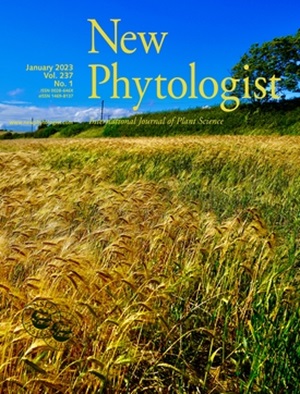Fruit nectar or prefruit nectar? Implication of the postfloral nectar of Dendrobium chrysotoxum (Orchidaceae).
IF 8.1
1区 生物学
Q1 PLANT SCIENCES
引用次数: 0
Abstract
Postfloral nectar presenting on reproductive organs after pollination generally functions in plant defense to protect fruits and seeds, but the mechanisms for postfloral nectary development and nectar secretion remain largely unknown. We report the first case of postfloral nectar production in the genus Dendrobium (Orchidaceae). D. chrysotoxum produced postfloral nectar on the surface of the inferior ovary after pistil pollination. The features of postfloral nectar secretion were revealed through anatomical and histochemical approaches, transcriptome and metabolome analysis, pollination experiments, and field observations. A key role of stigmatic pollen germination in postfloral nectar induction was demonstrated as well as the ant attraction effect of the postfloral nectar. Unexpectedly, the secretion of postfloral nectar ceased before ovule fertilization, making it more like 'prefruit nectar' than 'fruit nectar' (generally referred to the postfloral nectar occurring on organs that used to be floral ovaries) since the ovaries had not yet become fruits. The clarification of pollen germination in postfloral nectar induction and the provoking thought to define postfloral nectar based on the fertilization status provide new insights into the understanding of postfloral nectar.水果花蜜还是果前花蜜?兰花科黄石斛花后花蜜的意义。
花后花蜜在授粉后呈现在生殖器官上,通常具有保护植物果实和种子的防御功能,但花后花蜜发育和花蜜分泌的机制尚不清楚。我们报道了石斛属(兰科)花后花蜜生产的第一例。花后花蜜在雌蕊授粉后的下位子房表面产生。通过解剖和组织化学方法、转录组和代谢组分析、授粉实验和野外观察,揭示了花后花蜜分泌的特征。揭示了花后花蜜诱导中柱头花粉萌发的关键作用以及花后花蜜对蚂蚁的吸引作用。出乎意料的是,花后花蜜的分泌在胚珠受精前就停止了,使其更像是“果前花蜜”而不是“果蜜”(通常指的是发生在曾经是花子房的器官上的花后花蜜),因为子房还没有变成果实。花粉萌发在花后花蜜诱导过程中的澄清,以及基于受精状态定义花后花蜜的启发思想,为理解花后花蜜提供了新的思路。
本文章由计算机程序翻译,如有差异,请以英文原文为准。
求助全文
约1分钟内获得全文
求助全文
来源期刊

New Phytologist
生物-植物科学
自引率
5.30%
发文量
728
期刊介绍:
New Phytologist is an international electronic journal published 24 times a year. It is owned by the New Phytologist Foundation, a non-profit-making charitable organization dedicated to promoting plant science. The journal publishes excellent, novel, rigorous, and timely research and scholarship in plant science and its applications. The articles cover topics in five sections: Physiology & Development, Environment, Interaction, Evolution, and Transformative Plant Biotechnology. These sections encompass intracellular processes, global environmental change, and encourage cross-disciplinary approaches. The journal recognizes the use of techniques from molecular and cell biology, functional genomics, modeling, and system-based approaches in plant science. Abstracting and Indexing Information for New Phytologist includes Academic Search, AgBiotech News & Information, Agroforestry Abstracts, Biochemistry & Biophysics Citation Index, Botanical Pesticides, CAB Abstracts®, Environment Index, Global Health, and Plant Breeding Abstracts, and others.
 求助内容:
求助内容: 应助结果提醒方式:
应助结果提醒方式:


